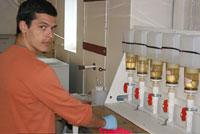

 | |||||||||||||||
|
|
Journals 2008/2009Jeff Lawrence
December 19, 2008 Most of us do not think about disease that may live within our oceans, but there are many that do. Scientists are trying to better understand these diseases, which include viruses. Just like with humans, viruses pose a great risk to life in our oceans. When you turn on the TV and hear about dolphins or whales being beached, the culprit could be related to a virus. Several years ago this was the case with a group of sea lions in California and again a group of dolphins that beached themselves in Florida. On this expedition to study coccolithophores blooms there was a concern that we would not be able to reach a particular bloom in time. Even tiny microscopic coccolithophores can be attacked and wiped out very quickly by a virus. Jack DiTullio is from the College of Charleston in South Carolina and does some of his work in coordination with NOAA by collecting samples to study. They want to know what these viruses are and how they may be mitigated from attacking the coccolithophore and other microorganisms. Peter Lee also works with Jack and is part of the same college. Although he is originally from New Zealand and has lived in Australia for a number of years before coming to the United States nine years ago. Jack, Peter, and another lab technician, Tyler Cyronak are studying these microorganisms to find out what types of viruses are present and attacking the coccolithophores. There work is very important not only to the marine life present in our oceans but also to humans.
There are several groups aboard the REVELLE that are studying these microscopic organisms and trying to extract their DNA and RNA when they return to their labs. On the ship they are filtering for coccolithophores, as well as other organisms. They are preserving them with liquid nitrogen so they can be taken to their labs for further analysis. This will require careful precision to extract the DNA from the samples so they can learn more about coccolithophores. Joaquin Martinez is here with Bigelow Laboratories to help Dr. Balch learn as much as possible about the coccolithophore. When a microscopic organism has a virus, the organisms who consume it become much more efficient in hosting much greater amounts of the virus, making it even more deadly as it goes up the food chain. This virus then works its way all the way up the food chain to fish such as tuna, mussels, oysters, and other seafood that humans eat. With ocean temperatures on the rise and increased levels of CO2 being found there is a concern that this problem may only worsen. Scientist today work diligently to head off the problem, by being proactive to find solutions that are both better for marine life and in turn for humans.
Questions of the Day:
|
||||||||||||||


